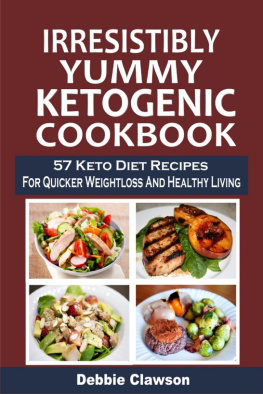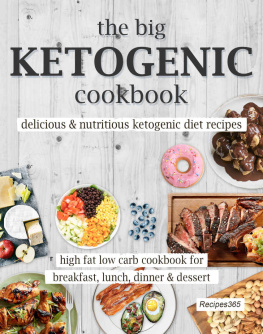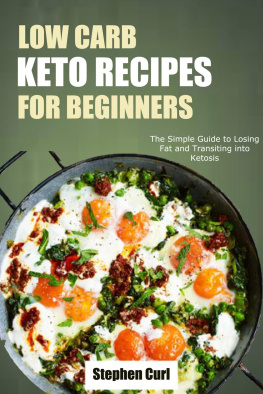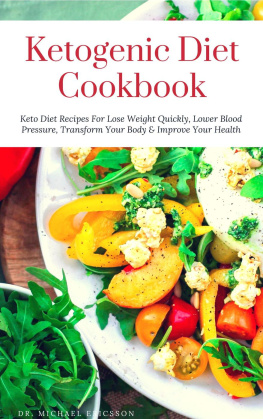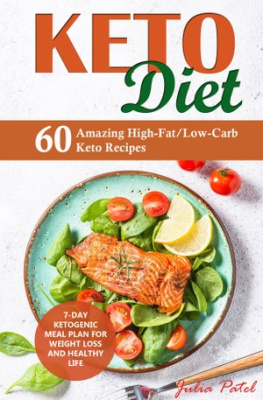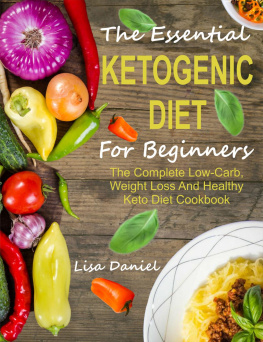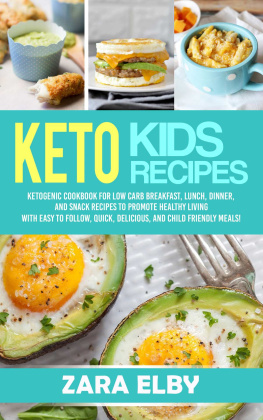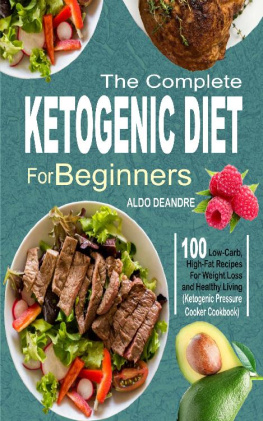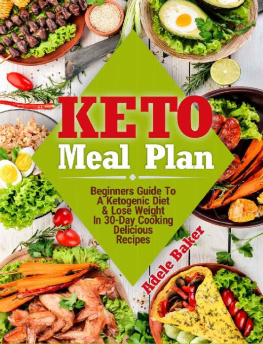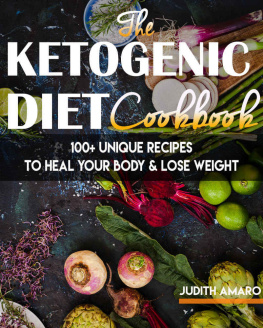Irresistibly Yummy Ketogenic Cookbook
57 Keto Diet Recipes For Quicker Weightloss AndHealthy Living
Debbie Clawson
Copyright 2014 by Debbie Clawson All rights reserved. No part of thispublication may be reproduced, distributed, or transmitted in anyform or by any means, including photocopying, recording, or otherelectronic or mechanical methods, without the prior writtenpermission of the publisher, except in the case of brief quotationsembodied in critical reviews and certain other noncommercial usespermitted by copyright law. Published by Winsome X Publishing atSmashwords 2015 Table Of Content INTRODUCTION Understanding The Keto Diet A keto diet is a low carbohydrate,high fat and moderate protein diet that causes the body to produceketones in the liver which are then used as energy. When a person consumes high or normalcarbohydrate, the body produces glucose and insulin which areeasily converted and used by the body as energy. Glucose is thepreferred or main energy source that is selected over any othersource of energy while insulin helps to process the glucose in thebloodstream. Here, fats are not needed but are merely stored.
However, when the carb intake is lowered, thebody enters a state of ketosis. During this state, the bodyproduces ketones which are the by-products of the broken down fatsin the liver. The body initiates ketosis to help people with lowfood intake survive. The main objective of a well-structured ketodiet is to force the body into this metabolic state. This isaccomplished by starving the body of carbohydrates and notcalories. Our bodies adjust easily to what it is given.
Once it isdevoid of carbohydrate and overloaded with fats, it will start toburn ketosis as its number one energy source for normal day to dayfunctions. It takes about 2 to 7 days for the body toadjust to this diet and go into ketosis. This is also dependent onthe individuals body type, levels of activity and what is beingeaten. Exercising on an empty stomach, restricting carbohydrateintake to 20g or less per day and taking lots of water are some ofthe fastest ways to get into ketosis. For a normal person starting a ketogenic dietand eating 25-40g of net carbs daily, the total process ofadaptation should take about 2 weeks. To attain ketosis within 1week, cut carbs down to fewer than 15g.
With a ketogenic diet, there will be no needfor you to worry about calories as the fats and proteins arefilling and will keep you full for an extended period of time.However, if you exercise, you must be more vigilant as exercisecomes with a greater calorie deficit that must be replenished. Be sure to always consult your physician ifyou have reservations about starting a ketogenic diet.Nevertheless, you MUST see a physician if you come from a familywith a history of diabetic or pre-existing conditions becausehigher intake of protein will definitely put a strain on thekidneys. Benefits Of A Keto Diet Besides its obvious weight loss benefit, theketogenic diet has been widely proven to improve cholesterol, bloodsugars, and reduce heart diseases. It is already a well-establishedform of treatment for epilepsy and research is presently going onto discover ways it can be used to treat other neurologicalconditions. It also helps to eliminate irritable bowelsyndrome, dementia and Alzheimer as well as to regulatemenstruation. Basically, it operates in a rather differentway than medications.
While scientists have discovered severaldifferent mechanisms of action leading to the diets success, onesignificant theme is that instead of causing sedation, one commonside-effect of medication, this diet makes the individual morealert and focused. In a nutshell, a few benefits of the dietare: Weight Loss - As yourbody burns fat as the primary energy source, it will start to usethe stored fat as an energy source while you are in a fastingstate. Energy - since yourbody now has better and more dependable energy source, you willbegin to feel more energized all through the day. Fats have beenconfirmed as the best molecule to burn as fuel. Fighting Hunger - Fatis satiating. You will feel fuller for a longer period of time asa result hunger cravings, common in other forms of dieting, will bealmost non-existent.
Blood Sugar -According to documented studies, there is a decrease of LDLcholesterol after a while which eliminates ailments such as type 2diabetes. Cholesterol - thisdiet brings about an improvement in triglyceride levels andcholesterol levels which are most associated with the buildup ofarterial. Eliminating Acne -latest research has shown that it leads to a reduction in skininflammation and acne lesions within 12 weeks. What To Eat Keto dieting requires lots of planning ahead.If you want to get to a ketogenic state quickly, you need to have aworkable diet plan. While 20-30g of net carbohydrate isrecommended for daily dieting, you will enter ketosis faster is yourestrict your carb intake to less than 15g a day. Strive to keepyour glucose level as low as possible and be aware of the net carbof each meal.
A net carb is the total dietary carbohydrate withoutthe total fiber. For example, 1 cup of broccoli contains6gcarb and 2g fiber. To calculate the net carb, simply take thetotal carb (6g) and subtract the dietary fiber (2g). This willleave us with a net carb of 4g. The ideal percentage of keto consumption is5% carbohydrate, 70% fats and 25% protein. Your carbohydratesshould mostly come from vegetables, dairy and nuts.
Do not eatrefined carbohydrates like wheat (pastas, cereals, breads,), starch(legumes, beans, potatoes) or fruit. The best choice of vegetables is always darkgreen and leafy. Your meals should mostly be a protein withvegetables, and an extra side of fat. Examples of these are chickenbreast in olive oil, with cheese and broccoli; Steak topped withbutter, and a spinach side sauted in olive oil. If you find yourself hungry throughout theday, snack on peanut butter, seeds, nuts and cheeses to curb yourappetite. The diets main sources of fat include: * Butter * Heavy cream * Oils (coconut, vegetable, olive, etc.) Many stricter forms of the diet do not allowthe following foods: * Pasta * Potatoes * Rice * Candy * Bread * Cereals The Most Common Low-Carb VegetablesInclude: Vegetable Amount NetCarbs Lettuce (Romaine) 1/2 Cup 0.2 Spinach (Raw) 1/2 Cup 0.1 Cauliflower (Steamed) 1/2 Cup 0.9 Cauliflower (Raw) 1/2 Cup 1.4 Bok Choi 1/2 Cup 0.2 Broccoli (Florets) 1/2 Cup 0.8 Cabbage (Green Raw) 1/2 Cup 1.1 Kale steamed 1/2 Cup 2.1 Collard Greens 1/2 Cup 2 Green Beans steamed 1/2 Cup 2.9 At the start of the keto diet plan, you maystill have intense sugar cravings as most people do but this willdissipate within a couple of weeks.
Sweeteners can be of help during this period.However, you must be careful because even things that are listedcarb-free may still contain carbs. Also, to not forget to takeinto consideration the net carbs of the sweetener when writing yourketo diet plan. Recommended Sweeteners Include: Sucralose or splenda - which is usually sold in granulated form. It contains bulkingagents which reduces the sweetness. One packet of splenda contains1net carb. Stevia - Also knownas the sweet leaf, stevia is a natural herb that is gotten byextracting the sweetener inside the leaf as a sugar substitute.
Ithas no vitamins, minerals or calories. It is extremely sweet, about200 times sweeter than sugar so use sparingly. It can be bought inliquid forms or granulated forms. Erythritol - A sugaralcohol naturally found in vegetable and fruits. It contains about70% sugar sweetness so you may need to add a little more thannormal. It should also be safely consumed at a maximum of 1 gramper kilogram of body weight.
Xylitol causes toothdecay, according to research so do not use. Steer clear ofAspartame as well. Changes In The Body Your body is accustomed to thestraightforward routine of breaking carbohydrates down and usingthem as energy. To accomplish this process, it has built up aresource of enzymes overtime and has only a handful of enzymes forhandling fats. As a result, the body merely stores them. Now, your body has to handle the increase infats and the lack of glucose.

